#pacific whale foundation
Explore tagged Tumblr posts
Text
at least there are friends of the library book sales
#//juri speaks#i got a book from the late 1800s on PE exercises; a signed pacific whale foundation book on humpbacks in hawaii#a vinyl of the flying dutchman (WITH a BOOKLET!!)#and three CDs!#all for $3!!#if i had more storage space i would have probably also left with like 5 volumes of LP sets of bach organ music#and an ooooold old old old set of library reference encyclopedias
2 notes
·
View notes
Text
Motion Sick
Angel Reyes x F!Reader From these August Prompts: “I don’t usually get motion sick but— oh, I think I’m gonna puke.” A/N: Hope you’re enjoying the fic a day challenge with me! Word Count: 1.6k Warnings: Mentions of pregnancy. Fluffy but light angst.
Mayans MC Taglist: @drabbles-mc @justreblogginfics @narcolini @danzer8705
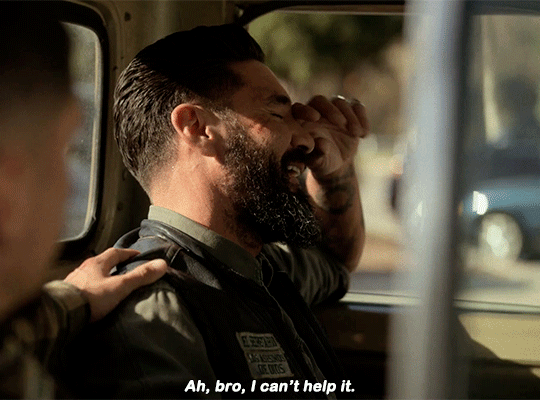
It was the middle of the day and you were traveling back home from a club errand with Angel. You might’ve had the day off but Angel didn’t and you figured if you were gonna snag anytime with him alone this was going to be it. Things had been busy between the club and the scrapyard. There wasn’t even a point in asking Angel if the errand he was running was for either because it likely had to do with both. All you knew is Angel had mentioned needing to take a ride to Santa Ana in the morning before he left your house and you met him at the clubhouse and hopped in the passenger seat of the van without any argument on his side.
Angel didn’t mind the company, if anything he enjoyed it. These days it was rare you two got to do anything together besides roll over and shake the other to shut off the alarm so taking a ride together was like a date on the town for you.
The ride up was smooth and quick, both of you wanted to get the errand done as soon as possible so that the rest of the day was your own without any responsibilities lingering over your head. The way back was more enjoyable. Angel took the long way back down the Pacific Coast Highway to give some romance to the trip, opting to stop at a whale watching point because he really wanted to spend as much time as he could with you. It was nice, it was something that had been missing between you two lately and this was his way of acknowledging it.
As you got back on the road you started to fidget in the passenger seat. Finding a comfortable position was making itself hard as you moved around.
“You alright? You can’t sit still.” Angel looked over at you as you switched to your 4th position in the last minute.
“Yea, just feel uncomfortable. I don’t know what it is.” You frowned and leaned forward to grab the handle that would easily adjust the seat back in hopes that would help.
“You think it was the lookout dock? The waves and shit making you sick?” The worry grew in his voice as he slowed down on the highway, taking the opportunity to look at you longer verse the road to get a better understanding about what was going on.
“I don’t know, I don’t think so. We were on solid foundation not like a dock or anything that was moving. Maybe I’m just getting antsy from the ride.” You brushed off his concern.
“Look, maybe you just need a break, we can stop and get some fuckin’ food or some shit.” Angel was starting to argue with you now, not out of spite, but from a genuine place. “You’re probably just motion sick. We’ve been in this van for a minute.” He had already begun to pull over at whatever food stop was coming up before you could put up a fight but it didn’t stop you from trying.
“I don’t usually get motion sick,” your hand lifted to wave him off to continue driving until you almost immediately brought it to your mouth, “oh– I think I’m gonna puke.”
Luckily the car was stationary as you opened the passenger door and vomited out of it. Angel thinking quickly to lean over and pull anything out of the way of your upchucking.
“Damn querida. I thought you didn’t get motion sick.” He said when you finally stopped and used one of the napkins that was shoved in the side pocket of the car to wipe your mouth off. As he spoke you turned to him and lifted your middle finger which made him laugh.
“I feel like shit.” You closed your eyes and leaned back in the seat.
“You need anything? I’ll get the food to go, we can grab a spot in the grass or something, I’m sure we got a blanket somewhere back here.” Angel went into full solution mode.
“If I sit on any blanket that’s in this van I’ll end up sicker than I am right now.” You let out a chuckle and let your head fall to the left to stare at Angel. He was on edge, you could tell. His arm was on the steering wheel and his body was twisted to look back at you. “Why don’t we find a convenient store, like a CVS or Rite Aid or some shit, I think I’ll get better if I get my hands on a gatorade and some saltines.”
Angel was moving in seconds, he had put the car in drive and you were about to argue it but he spoke up. “I’m just moving it up a couple feet so you don’t step in your own vomit.” His smiled openly.
“Angel the angel.” You teased him as you stepped out the van.
The convenient store was close, it was a matter of minutes before you both entered the air conditioned building that was playing some top 40’s radio station through the speakers. The cold breeze already had you feeling better, the club van didn’t exactly have the best AC for an old overused vehicle.
“Grab what you want, I’m gonna see if I can get you some of that motion sickness shit from the pharmacy, half the shit on the PCH is behind lock and key.” Angel placed a quick kiss on your head before walking towards the medicine aisle. “Oh and maybe pick up some Listerine or toothpaste!” His whole body turned around as he kept walking backwards with his nose scrunched up.
That earned him another middle finger and a headshake, although, you knew he was right. Toothpaste and a toothbrush was the first thing you were grabbing on your way to grab the essentials but he didn’t need to be annoying about it.
As you entered the toiletry aisle your eyes scanned the shelves. Mouthwash was first, and while it was a viable option, you knew brushing your teeth would be a greater benefit for both of you. As your eyes moved to the toothpaste, you saw the travel brush and paste kit and grabbed the first one you saw before walking down the rest of the aisle. You browsed the rest of the aisle, taking your time not wanting to leave the cooled store anytime soon. As you looked around your eyes stopped on a box of tampons. That’s when it hit you like a tons of bricks. The speed at which you took your phone out your backpocket was unmatched, all just for your thoughts to be confirmed by the date displaying on your phone. You were late.
Without a second thought you grabbed the pink box that was to the right of the pads and tampons and flew to the bathroom. Luckily it was on the opposite side of where the pharmacy was so there was no chance you were going to run into Angel.
3 minutes was beginning to feel like 3 days with how long it was taking. You had grabbed the digital test, which was likely the more expensive one but at this point you didn’t care. You stood over the sink staring at the flashing lines waiting for words to pop up on it. You could’ve taken the time to brush your teeth but you felt like if you took your eyes off the test, you’d miss something.
You heard the digital beeping and the words appeared across the screen.
Pregnant.
“Holy shit.”
You weren’t exactly sure how to feel but before you could really even process it, you were stepping out of the bathroom and looking down the aisles for Angel.
He was in the toy section, gatorade and saltines in one hand and a squishmallow in the other.
“Hey look! It kinda looks like Sally right? I know it’s a seal but they got the same fuckin’ eyes.” Angel held up the gray stuffed animal and compared it to his little brother’s dog.
As you walked over to him and said nothing his smile started to fade.
“You get sick again?” He asked a follow up question.
Without saying anything you held up the pregnancy test for him to see. It took him a couple seconds to process what you were showing him before he was picking you up in the air in celebration. The squeal that left your mouth was full of shock but the laugh that came after was genuine. Angel was clearly excited about this and that sent a wave of relief through you that let you enjoy this.
“Alright, alright, put me down you’re gonna make me sick again!” You spoke through another laugh.
“What happened, I thought you don’t get motion sick.” His voice got deeper as he mocked you and put you down.
“Yea I don’t, but apparently your kid does.”
Angel’s smile grew even bigger at that sentence. You leaned over and grabbed the squishmallow from him and made your way to the front of the store to pay for everything you two had gathered up.
“We gettin’ that?!” Angel lightly jogged to catch up to you.
“Baby’s first toy?” You squished it against your front in a hug.
Angel brought you into his side, throwing his arm around you as he left a soft his on the crown of your head.
“Yea, baby’s first toy.”
#Angel Reyes#Angel Reyes Fic#Angel Reyes Fanfic#Angel Reyes Fanfiction#Angel Reyes x Reader#Angel Reyes x You#Mayans Mc#Mayans FX#mayans mc fanfiction#my writing#garbinge
305 notes
·
View notes
Text
The photographers shared their footage with a marine mammal expert, who confirmed that both whales were in fact, male. This confirms what we already know: gay and bisexual behaviour is common among animals. PhD student Stephanie Stack from the Pacific Whale Foundation was contacted by two photographers who photographed two humpback whales in Maui, er, well, humping. Lyle Krannichfeld and Brandi Romano got in touch with Stack because they knew the recording was rare, but they didn’t realise how revolutionary their recording was.
Continue Reading.
109 notes
·
View notes
Text
What are Phytoplankton and Why Are They Important?
Breathe deep… and thank phytoplankton.
Why? Like plants on land, these microscopic creatures capture energy from the sun and carbon from the atmosphere to produce oxygen.

Phytoplankton are microscopic organisms that live in watery environments, both salty and fresh. Though tiny, these creatures are the foundation of the aquatic food chain. They not only sustain healthy aquatic ecosystems, they also provide important clues on climate change.
Let’s explore what these creatures are and why they are important for NASA research.
Phytoplankton are diverse
Phytoplankton are an extremely diversified group of organisms, varying from photosynthesizing bacteria, e.g. cyanobacteria, to diatoms, to chalk-coated coccolithophores. Studying this incredibly diverse group is key to understanding the health - and future - of our ocean and life on earth.

Their growth depends on the availability of carbon dioxide, sunlight and nutrients. Like land plants, these creatures require nutrients such as nitrate, phosphate, silicate, and calcium at various levels. When conditions are right, populations can grow explosively, a phenomenon known as a bloom.
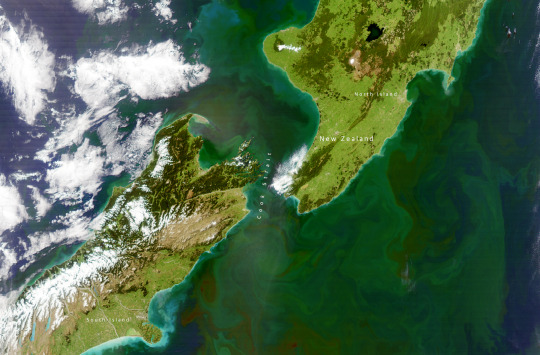
Phytoplankton blooms in the South Pacific Ocean with sediment re-suspended from the ocean floor by waves and tides along much of the New Zealand coastline.
Phytoplankton are Foundational
Phytoplankton are the foundation of the aquatic food web, feeding everything from microscopic, animal-like zooplankton to multi-ton whales. Certain species of phytoplankton produce powerful biotoxins that can kill marine life and people who eat contaminated seafood.
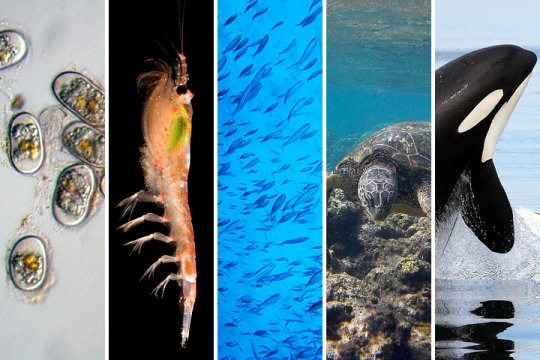
Phytoplankton are Part of the Carbon Cycle
Phytoplankton play an important part in the flow of carbon dioxide from the atmosphere into the ocean. Carbon dioxide is consumed during photosynthesis, with carbon being incorporated in the phytoplankton, and as phytoplankton sink a portion of that carbon makes its way into the deep ocean (far away from the atmosphere).
Changes in the growth of phytoplankton may affect atmospheric carbon dioxide concentrations, which impact climate and global surface temperatures. NASA field campaigns like EXPORTS are helping to understand the ocean's impact in terms of storing carbon dioxide.

Phytoplankton are Key to Understanding a Changing Ocean
NASA studies phytoplankton in different ways with satellites, instruments, and ships. Upcoming missions like Plankton, Aerosol, Cloud, ocean Ecosystem (PACE) - set to launch Jan. 2024 - will reveal interactions between the ocean and atmosphere. This includes how they exchange carbon dioxide and how atmospheric aerosols might fuel phytoplankton growth in the ocean.
Information collected by PACE, especially about changes in plankton populations, will be available to researchers all over the world. See how this data will be used.
youtube
The Ocean Color Instrument (OCI) is integrated onto the PACE spacecraft in the cleanroom at Goddard Space Flight Center. Credit: NASA
1K notes
·
View notes
Text
I enjoyed "The Jeroboam's Story". Every time the Pequod meets another ship, we see that maybe whaling is just Like That, actually. The Pequod and the Jeroboam have both come under the control of a man who managed to hide his monomania long enough to board a ship and subvert the crew to his will. The difference is that Gabriel wants to be God's vicar to the Pacific, while Ahab wants to kill Him.
Speaking of God, the Jeroboam has had a run-in with Moby Dick too, because of course they have. He's everywhere. I was struck by the description of Macey being "smitten" - a telling choice of words - while the boat and the rest of the crew remain untouched. The Whale is simply, unquestionably more powerful than any human. And Macey condemned to "for ever sink" into the same depths we heard about last chapter, the "world's foundations", "where bell or diver never went" - the place that the Whale calls home and that Ahab can barely even imagine.
71 notes
·
View notes
Text
Hello Tumblr friends and anyone who comes across this post
So I'm sure everyone is aware of the terrible wildfires that Maui recently went through and have seen plenty of posts sharing links to different ways they can help out the people of Maui
I have a sister who lives there and thankfully was not harmed and is now doing her part to help rebuild what was destroyed. She was also kind of enough to share links that will directly help the people of Maui
I figured I could share those here:
'Aina Momona: MAUI RELIEF | ainamomona (kaainamomona.org) <- This is a Native Hawaiian organization whose purpose is achieving environmental health and sustainability in Hawaii. Currently they are taking donations to help support the people of Maui
Petition · Lahaina Town Recovery- Stop Big Business Development · Change.org <- This is a Change.org petition started by a resident of Lahaina that is trying to prevent big businesses from exploiting this tragedy and using it as an opportunity for their own and it still needs plenty of signatures. They're also asking for donations of at least $8 so if you are signing it, please donate
And something I want to add myself:
My sister works at the Pacific Whale Foundation (or PACWhale Eco Adventures) which is a non-profit organization that protects the ocean as well as marine life. They currently have their own Emergency Relief Fund as well: Emergency Relief Fund (pacificwhale.org)
Their organization makes a lot of their money through their whale tours where most of their passengers are tourists. It's gonna be very unlikely that they'll be doing any tours any time soon so if you wish to donate to their organization here is a link for that: You Can Help | Pacific Whale Foundation
39 notes
·
View notes
Text
Excerpt from this story from National Geographic:
Ship collisions with the world’s rarest whales have garnered global attention. But until recently, scientists didn’t realize these same vessels are likely killing whale sharks, an endangered species and the world’s largest fish.
In a new study, over 75 researchers came together to quantify the threat shipping may pose to whale sharks, which live in warm tropical and sub-tropical waters around the world, including the Indian, Pacific, and Atlantic Oceans.
The scientists mapped whale shark aggregation hot spots—known as constellations because of the sharks’ star-like patterns across their backs—in 26 countries and overlaid them with information on the positions of large ships, provided by Global Fishing Watch, a nonprofit that uses technology to increase transparency around how our oceans are used and managed.
They found the sharks were most in danger in heavily trafficked regions of Ecuador, Mexico, Malaysia, the Philippines, Oman, Seychelles, and Taiwan. While it’s unknown how many sharks are dying, their proximity to so much shipping activity suggests the burden is high, says lead author Freya Womersley, a researcher at the Marine Research and Conservation Foundation and the University of Southampton in the U.K.
Whales, such as right whales, stay near the surface to breathe air, making them particularly vulnerable to hitting ships. Although whale sharks, which often reach 32 feet long, don’t need to come up to breathe, they spend around half their time cruising at the surface feeding on plankton.
“The data the study pulled together from tagging whales sharks all over the world just shows how much time they're spending in that high-risk zone,” says Michael Heithaus, a shark ecologist at Florida International University who was not involved in the study, published in May in the journal Science of the Total Environment.
As shipping increases globally, these experts say it’s vital to act now to protect sharks: There are more than 100,000 ships moving goods worldwide, and the number could grow by as much as 1,200 percent by 2050.
11 notes
·
View notes
Text
Danish police on Sunday arrested prominent anti-whaling activist Paul Watson when his vessel came to port in Greenland, citing a warrant issued by Japan, a whaling nation that seeks his extradition.
Watson, a 73-year-old Canadian American who co-founded Greenpeace and founded Sea Shepherd, was traveling with 25 volunteers aboard the 236-foot M/Y John Paul DeJoria on a mission to the North Pacific for the Captain Paul Watson Foundation (CPWF), which he started after leaving Sea Shepherd in 2022.
When the vessel arrived in Nuuk, Greenland to refuel, the Danish police immediately boarded and arrested Watson.
The CPWF denounced the surprise arrest, which came as Watson planned to intercept a new Japanese factory whaling ship.
"We implore the Danish government to release Captain Watson and not entertain this politically-motivated request," Locky MacLean, CPWF's ship operations director, said in a statement.
Sunday's arrest came as the M/Y John Paul DeJoria was making its way to the North Pacific via the Northwest Passage after setting off from Dublin. The CPWF team aimed to intercept the Kangei Maru, a new 370-foot, $48 million Japanese factory whaling ship that's equipped with state-of-the-art drones that expedite the killing of whales.
CPWF argues that the launch of the new vessel signals Japan's ambitions to restart commercial whaling on the high seas—international waters—in the North Pacific and the Southern Ocean as early as 2025. Japan long whaled the high seas in defiance of international law, under the guise of scientific research, but in recent years it has shifted to whaling in its own territorial waters, which extend 200 nautical miles from its shores.
Watson, who is known for confrontational tactics, was the star of the Animal Planet television show Whale Wars that ran from 2008 until 2015, in which he lead efforts to disrupt Japanese whaling on the high seas.
3 notes
·
View notes
Text
Humpback whales make one of the longest migrations of any mammal on the planet. One of the most closely watched routes spans 4,830km (3,000 miles), from Alaska to their breeding grounds in Hawaii. The creatures give birth in sea temperatures between 21C and 28C (70F and 82F), which is ideal for calves who don't have as much blubber as full-grown whales. As the globe's temperature patterns shift, however, scientists are warning that the whales may be forced off course. By the end of this century, rising greenhouse gas emissions will put several breeding grounds across the Earth's hemispheres outside the humpback's temperature tolerance, according to a 2022 study from the University of Hawaii in collaboration with the Pacific Whale Foundation.
Riley Farrell, ‘Too hot for humpbacks: The race to protect Pacific whales’, BBC
2 notes
·
View notes
Text
5 Random Things I Enjoy
I was tagged by @dirty-bosmer @throughtrialbyfire and @thequeenofthewinter to share 5 random things I enjoy, thanks for the tag all of you <3
I'm tagging @akaviri-dovah @ladytanithia @crysdrawsthings @greyborn2 and @your-talos-is-problematic @lucien-lachance
Painting: I've done many forms of traditional and textile art like sewing, beading, clay, charcoal but my favourite form is acrylic on canvas <3
Epic Poetry: I read the Iliad in my first semester in undergrad and I became hooked on epic poetry ever since! My two favs would have to be the Iliad and the Divine Comedy (which I'm currently reading right now)
The Ocean: I grew up with the Atlantic Ocean as my front yard and now I live right along the pacific. The ocean truly is my happy place, I love swimming, looking for seashells, the cool creatures that live there like sharks and whales.
Music: Lately I've been replaying two songs on repeat, Cosmic Love by Florence + the Machine and Francesca by Hozier (beautiful song plus about Inferno??? say no more I'm there)
Makeup: I've recently have gotten back into makeup as a form of self-expression. I realized that I didn't like wearing foundation so ive just decided my skin is fine and to only do the makeup I think is cool. I'm a big fan lots of blush, dark lips and bold eyes
12 notes
·
View notes
Photo


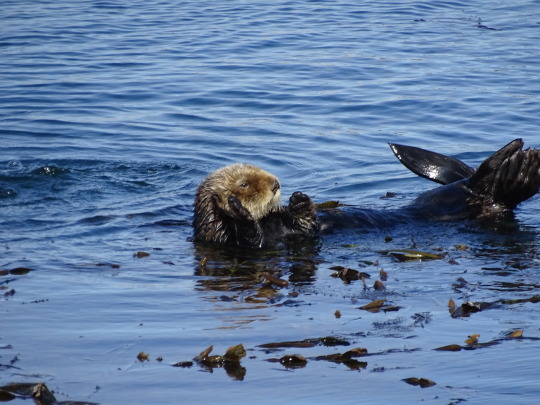
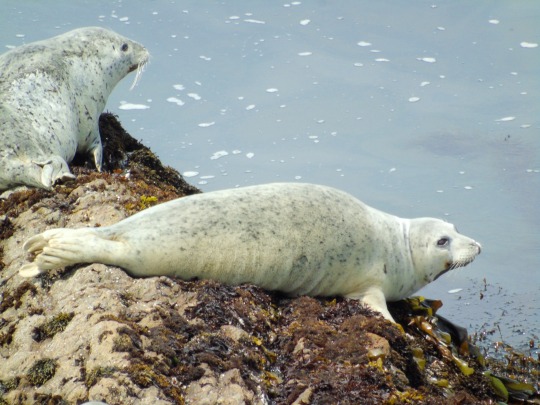

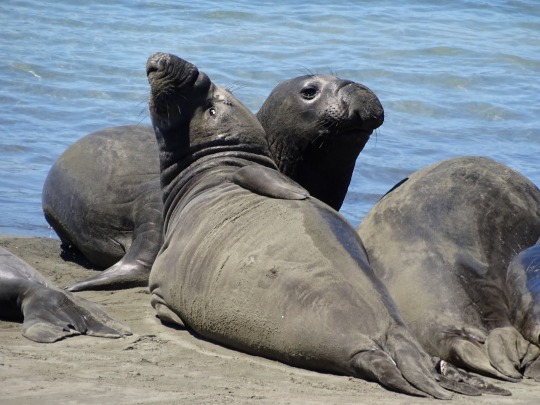
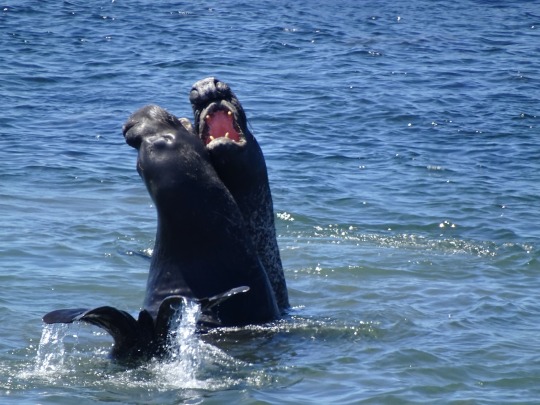
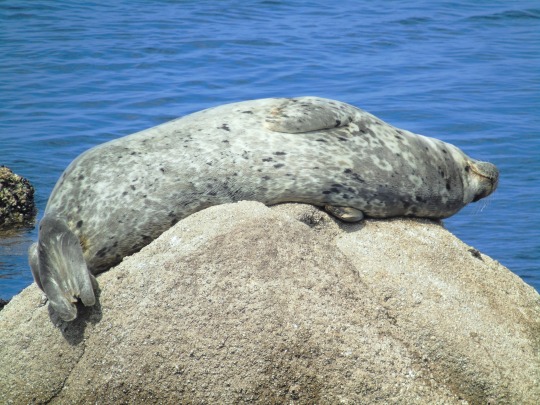


Marine Mammal Rescue Day
With countless threats now facing the ocean, marine mammals need extra help. Donate or volunteer to aid these creatures against extinction and endangerment.
Mammals under the sea have a plight that is much different than those living on the surface of the earth. But that doesn’t make them any less valuable! Dolphins, seals, whales, sea otters and other varieties have been struggling to get by below the surface of the ocean as the environment is not as hospitable as it once was.
Marine Mammal Rescue Day seeks to raise awareness for the plight of these creatures that are delightfully unique, rather cute, and also an important part of the ecosystems underwater. Join in on Marine Mammal Rescue Day and show some support for this amazing sea life on this day!
History of Marine Mammal Rescue Day
Marine mammals have a history that dates back farther than human history can tell. Originally hunted by native coastal people for food, pelts and fat, they have come a long way over time. Now, many of them struggle to survive due to the impact that humans are having on their lives.
Sadly, due to illness and malnutrition on the west coast of the United States, spring is the height of animal rescue season. Marine mammal rescue organizations along the coast of the Pacific Ocean gear up for the busy pinnipedia (aka seals) season as early as mid-January, when the delightful Northern Elephant Seals start being born.
Next, comes pupping season for the Harbor Seal and then the Sea Lion pups start being born mid to late June. The Pacific coast also is home to Northern Fur Seals and Guadalupe Fur Seal. And of course the Sea Otter.
Cetaceans (or whales) also need help from illness and injury during this time of the year as well as all year round. Polluted waters, marine debris and illegal fishing gear can contribute to harming and killing all manner of aquatic life.
Being good stewards of the planet should include the biggest part of it, the ocean and its inhabitants. The actions (and inaction) of humans have polluted and toxified the ocean. Overall climate change has warmed the oceans and altered the patterns where fish swim.
Marine Mammal Rescue Day was established to pay attention to the fact that these young marine mammals are frequently not strong enough to go far and deep enough to go after the fish they need.
In 2017, Senator Toni Atkins from the state of California proposed a bill that would create Marine Mammal Rescue Day. And though the day has its beginnings in the United States, the oceans are shared by people from nations all over the globe. So it’s important that the word gets spread about this day to raise awareness and show some support for these marine mammal friends!
How to Celebrate Marine Mammal Rescue Day
Let it be known that you care by supporting and helping these at risk creatures on Marine Mammal Rescue Day. Get involved with some of these ideas for celebrating the day:
Make a Donation for Marine Mammals
Various charitable and non profit organizations work hard to help support and protect marine mammal life. But they need financial help from individuals, companies and others. Marine Mammal Rescue Day would be an ideal time to make a donation to a group that helps these creatures. Here is a list of a few that might be considered:
Marine Mammal Care Center in Los Angeles, California
International Marine Mammal Project in Berkeley, California
Marine Mammal Foundation in Victoria, Australia
British Divers Marine Life Rescue in East Sussex, UK
Visit the Marine Mammal Rescue Center
Getting its start in 1975, the Marine Mammal Rescue Center is located in Sausalito, California. Each year, the center provides information and education to thousands of school children and others who are interested in helping to make sure their actions are beneficial to the lives of marine mammals. Celebrate Marine Mammal Rescue Day by visiting the center, learning more, and sharing information to raise awareness for the plight of these magnificent underwater creatures!
Source
#sea otter#Morro Bay#Pacific Ocean#summer 2022#travel#vacation#USA#Elephant Seals of San Simeon#northern elephant seal#California#West Coast#Elephant Seal Vista Point#2017#harbor seal#Monterey#Point Arena#wildlife#animal#original photography#tourist attraction#landmark#fauna#beach#Marine Mammal Rescue Day#27 April#MarineMammalRescueDay
18 notes
·
View notes
Text

Wildfires destroyed the historic town of Lahaina and killed at least 96 people, the need in Maui is still so great that when boats approach the western side of the island with donations, people run across the beach to welcome them. It’s a sight Edgar Rodriguez appreciates – and understands. Rodriguez and his family lost their Lahaina home to the flames. In the days since, he has shepherded supplies to those who stayed behind in the closed portion of the island with the Pacific Whale Foundation, a marine conservation nonprofit.
The foundation sprung into action in the immediate aftermath of the fire, collecting donations for its workers who lost homes, and utilizing the boats they would normally use for tours, to deliver supplies to areas in need. “It’s people helping people,” said Dayna Garland with the foundation. “We don’t know how to sit around and wait.”
Courtesy The Guardian #peoplehelpingpeople
5 notes
·
View notes
Text
The Magnificent Gray Whale: Ocean Voyager and Ecosystem Engineer
Gray whales, scientifically known as Eschrichtius robustus, are majestic marine mammals that captivate the imagination of scientists and nature enthusiasts alike. These gentle giants, measuring up to 49 feet in length and weighing up to 90,000 pounds, are renowned for their incredible migratory journeys and unique feeding habits.
Native to the North Pacific Ocean, gray whales are divided into two distinct populations: the Eastern North Pacific (ENP) and Western North Pacific (WNP) groups. The ENP population, which has made a remarkable recovery from near-extinction, undertakes one of the longest migrations of any mammal. Each year, they travel an astounding 10,000-14,000 miles round trip between their summer feeding grounds in the Bering and Chukchi Seas and their winter breeding lagoons in Baja California, Mexico.
Whale watching in Baja are easily distinguishable by their mottled gray coloration, heart-shaped blows, and lack of a dorsal fin. Instead, they possess a dorsal hump followed by a series of knuckles along their back. Their unique feeding strategy sets them apart from other baleen whales. As bottom feeders, they roll onto their sides and scoop up sediment from the ocean floor, filtering out small crustaceans, mollusks, and other invertebrates through their baleen plates.
These whales play a crucial role in their ecosystem as bioturbators. Their feeding behavior stirs up sediment, releasing nutrients back into the water column and supporting the growth of phytoplankton, the foundation of the marine food web. This process also helps oxygenate bottom sediments, benefiting various benthic organisms.
Gray whales face numerous challenges, including entanglement in fishing gear, ship strikes, and the impacts of climate change on their Arctic feeding grounds. The loss of sea ice due to global warming affects the abundance and distribution of their prey, potentially altering their migratory patterns and feeding behavior.
Conservation efforts have yielded positive results for the ENP population, which has rebounded from fewer than 2,000 individuals in the early 20th century to around 20,000 today. However, the WNP population remains critically endangered, with only about 200 individuals remaining.
Research on gray whales continues to reveal fascinating aspects of their behavior and biology. Recent studies have shown that some individuals exhibit flexibility in their feeding strategies, adapting to changing environmental conditions by feeding in coastal waters during their migration.
The cultural significance of gray whales cannot be overstated. They have been an integral part of indigenous cultures along the Pacific coast for thousands of years, featuring prominently in traditional stories, art, and subsistence practices. Today, they are a major draw for ecotourism, particularly in their breeding lagoons in Mexico, where curious individuals often approach boats, allowing for close encounters that foster public appreciation and support for conservation efforts.
As sentinel species, Baja gray whale watching serve as indicators of ocean health. Their well-being reflects the overall condition of marine ecosystems, making them valuable subjects for long-term environmental monitoring. By studying changes in their population dynamics, migration patterns, and body condition, scientists can gain insights into broader oceanic trends and the impacts of climate change.
In conclusion, gray whales are not only awe-inspiring creatures but also vital components of marine ecosystems. Their remarkable journeys, unique feeding habits, and ecological importance underscore the need for continued conservation efforts and scientific research. As we face unprecedented environmental challenges, the story of the gray whale's recovery offers hope and serves as a powerful reminder of nature's resilience when given the chance to thrive. https://www.greywhale.com/gray-whale-watching-in-baja/
0 notes
Text
France opposes extradition of anti-whaling activist Watson to Japan
French President Emmanuel Macron’s office said it is pressuring Danish authorities not to extradite arrested anti-whaling activist Paul Watson to Japan, according to France 24.
Watson, the 73-year-old American-Canadian founder of activist group Sea Shepherd, had been living in France for the past year. Macron is “following the situation closely” and “intervening with the Danish authorities”, his office at the Elysee Palace said.
Watson was arrested in Greenland, an autonomous territory of Denmark, on Sunday on an international arrest warrant issued by Japan. He will remain in custody until 15 August, while Denmark’s justice ministry must decide whether to extradite him.
In France, an online petition to Macron calling for Watson’s release has garnered 388,000 signatures. Green Party lawmakers have also put pressure on Macron, with 89-year-old film legend Brigitte Bardot saying on Monday:
We must do everything to save Paul.
Watson’s ship docked in Greenland’s capital Nuuk on Sunday to refuel and he was arrested on board. The ship was on its way to “intercept” a Japanese vessel to hunt and process whales in the North Pacific, the Captain Paul Watson Foundation said in a statement.
Japan is one of the last three countries in the world to allow commercial whaling, along with Iceland and Norway. Watson’s foundation said it has been the subject of an Interpol red notice due to events during a collision with a Japanese whaling vessel in the Antarctic dating back to 2010, including property damage and injuries. Francois Zimeray, one of Watson’s lawyers, stated:
The Japanese arrest warrant is illegal. It violates all international human rights treaties.
Read more HERE

#world news#news#world politics#europe#european news#european union#eu politics#eu news#france#france news#french politics#emmanuel macron#president macron
0 notes
Text
Edward Carver: Anti-Whaling Activist Paul Watson Arrested in Greenland, May Face Extradition to Japan
The famed campaigner was en route to intercept a new 370-foot Japanese factory whaling ship in the North Pacific when Danish police in Greenland made the surprise arrest, citing an international warrant issued by Japan. Danish police arrested anti-whaling activist Paul Watson when his vessel came to port in Nuuk, Greenland, on July 21, 2024. (Photo: Captain Paul Watson Foundation) Danish…
#climate change#Denmark#endangered species#Greenland#Greenpeace#Japan#Paul Watson#Sea Shepherd#whales
0 notes
Text
Each year humpback whales travel thousands of miles from their polar feeding grounds to the tropical waters where they mate, give birth and nurse their calves. But despite the breeding season attracting tourists and scientists from around the world, sexual behavior among humpback whales had never been documented—until now.
And the world’s first photographs of humpback whales copulating are even more groundbreaking because both individuals were male.
The surprising images, published this week in a paper in Marine Mammal Science, were recorded by chance. In January 2022 Lyle Krannichfeld and Brandi Romano—two photographers based on the Hawaiian island of Maui—saw something strange. Two whales slowly swam toward their boat. Whale B kept approaching Whale A from behind, holding on with his pectoral fins and copulating with Whale A; each penetration lasted for less than two minutes.
The photographers knew sexual activity between humpbacks had never been scientifically observed or documented. But when they approached Stephanie Stack, a researcher at the Pacific Whale Foundation, for confirmation of what they’d seen, she noticed something else: “I said, ‘Oh, it doesn’t look like a female whale,’” says Stack, the new paper’s lead author.
Whale B had inserted his penis into Whale A’s genital slit, the opening that sheathes the penis when it is not extruded for mating. The penetrations were very shallow because “the humpback whale’s penis is quite large,” Stack says.
Images of each whale’s tail fluke, which can be used to identify an individual as effectively as a human fingerprint, were cross-checked on the global Happywhale.com database to confirm that both whales were sexually mature males. Whale A was at least 13 years old, and Whale B was around 30.
“Homosexual behavior is extremely common in the animal kingdom and very common for other species of cetaceans,” Stack says. Same-sex sexual acts play an important social role for common bottlenose dolphins (Tursiops truncatus), and homosexuality has been seen in other whales, dolphins and porpoises, including killer whales (Orcinus orca), gray whales (Eschrichtius robustus), bowhead whales (Balaena mysticetus) and Amazon river dolphins (Inia geoffrensis).
Homosexual acts have also been seen in other types of animals. For Octopoteuthis deletron, a squid living in the ocean’s twilight zone, coming across a potential mate is so rare that males randomly shoot sperm packets at any individual they encounter from their own species—male or female. And even though species of flatworms are hermaphrodites (organisms with both male and female reproductive organs), they duel with their penis to impregnate a mate and avoid the energetic cost of laying eggs themselves.
On land, same-sex sexual activity has been recorded in bonobos, flamingos, bison, geese, dragonflies and more.
There can be many reasons for homosexual behavior in the ocean: practicing mating, forming social bonds, reducing tension and showing dominance or aggression. But why were these two males doing it?
“It’s important to not look at this through a human perspective,” Stack notes. But she does have theories. It could, she says, be a way of developing social bonds—or male humpbacks could be in a heightened hormonal state during mating season.
“In the heat of the moment, they will seek anything they can find,” says Olaf Meynecke, a research fellow at Griffith University in Australia, who was not involved in the study but studies humpback whales.
There can be many reasons for homosexual behavior in the ocean: practicing mating, forming social bonds, reducing tension and showing dominance or aggression. But why were these two males doing it?
“It’s important to not look at this through a human perspective,” Stack notes. But she does have theories. It could, she says, be a way of developing social bonds—or male humpbacks could be in a heightened hormonal state during mating season.
“In the heat of the moment, they will seek anything they can find,” says Olaf Meynecke, a research fellow at Griffith University in Australia, who was not involved in the study but studies humpback whales.
A third possibility is that this was a show of dominance. “Males on the breeding grounds do compete against other males,” Stack says. The photographs in the paper show Whale A lifting his head, arching his lower back and lowering his tail, forming an S-shape—a position whales sometimes assume when feeling threatened or stressed.
What’s more, Whale A was sick. He was emaciated, and his body was covered in whale lice (Cyamus boopis), turning him a brownish color. These parasites live on a humpback’s skin and can multiply rapidly when the host is injured or sick. A serious jaw injury, probably from a boat strike, was likely the cause of this particular whale’s poor health because it affected his ability to feed. “It looks like the other male took advantage of the weak individual,” Meynecke says. Whale B was seen the following year, but there have been no more sightings of Whale A. Although not all whales are seen every year—so he might still return—the jaw injury may have been fatal.
Seeing whale copulation for the first time gives researchers more information about how it occurs, as well as the respective positions the whales can assume during mating. This will help them know what to look out for in the field or when reviewing existing data. “A pair of adult whales together may not have drawn a researcher’s attention under normal circumstances,” Stack says. “Now that we know this, maybe we’ll look a little more carefully.”
The new paper also shows the value of citizen science: having more people on the water with cameras can sometimes increase the chance of formally documenting new behaviors. “It would be nearly impossible to specifically design a study and hope to capture whales mating,” Stack says. “Maybe someday we’ll see mating between a male and a female humpback.”
1 note
·
View note